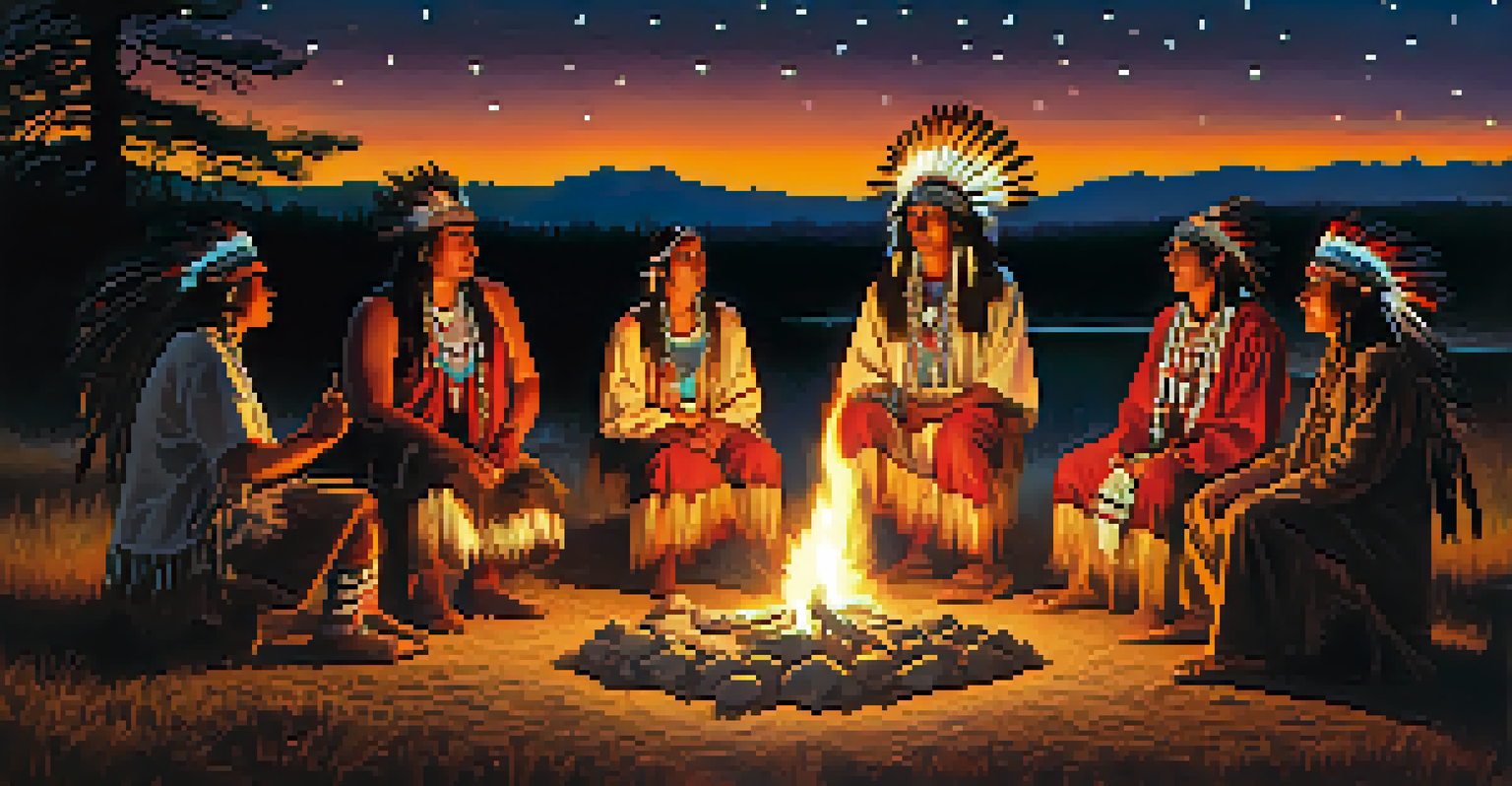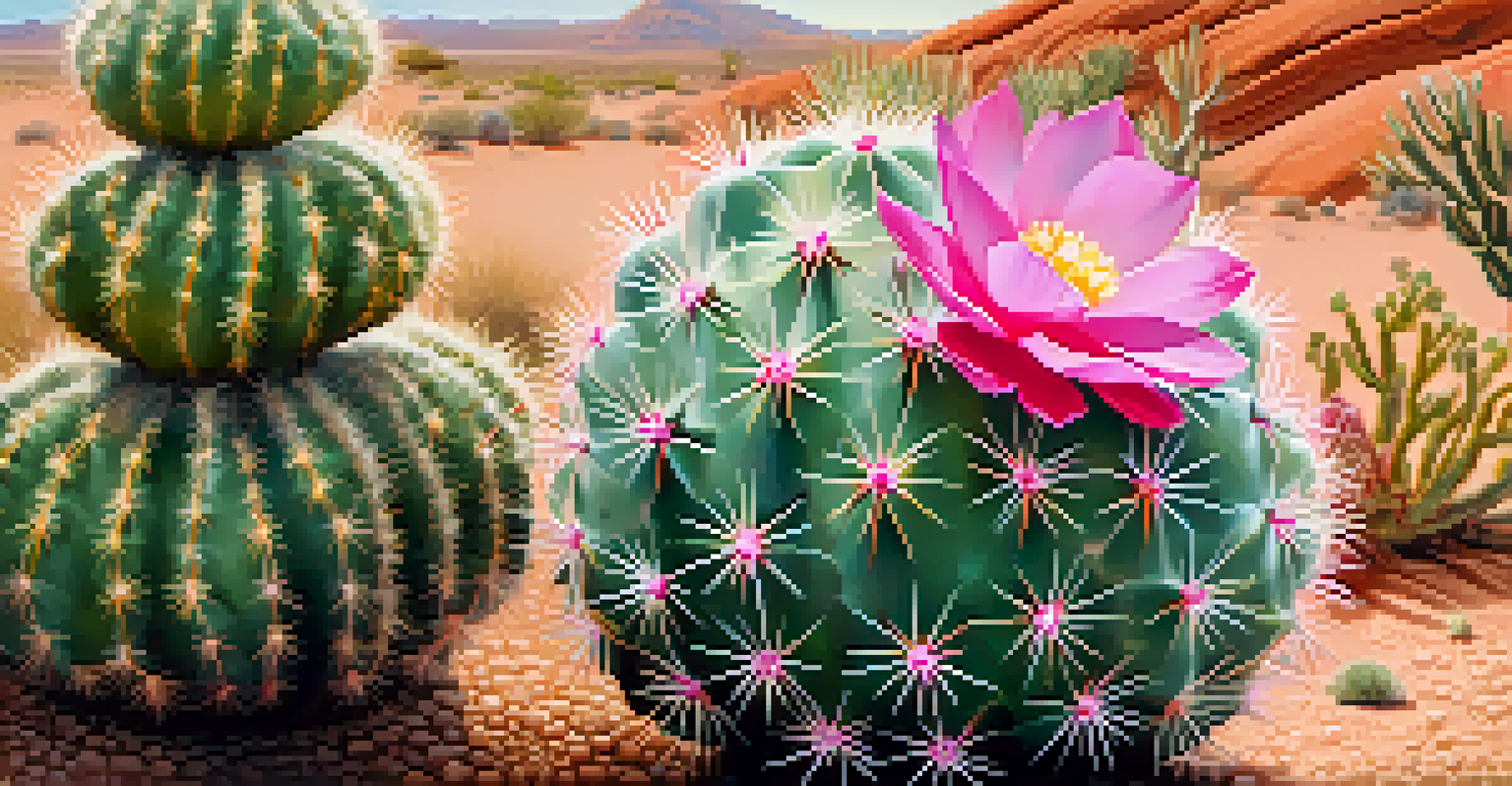Sacred Plants: Peyote in Global Spiritual Movements

Understanding Peyote: A Sacred Cactus
Peyote, a small cactus native to Mexico and the southwestern United States, has been used for centuries in various spiritual practices. Its psychoactive properties, primarily attributed to the compound mescaline, have made it a focal point for religious ceremonies. For many Indigenous cultures, peyote is not just a plant; it's revered as a sacred gift from the earth.
Psychedelics can help facilitate a deeper understanding of ourselves, our relationships, and the world around us.
The use of peyote dates back thousands of years, with archaeological evidence suggesting its consumption as far back as 5,700 years ago. This rich history highlights its importance in traditional ceremonies, often aimed at spiritual healing and connection with the divine. The ceremonies involving peyote are deeply rooted in community, showcasing a collective journey towards enlightenment.
Today, peyote's significance extends beyond traditional settings, influencing various global spiritual movements. Its role in these practices demonstrates the plant's adaptability and the universal quest for meaning and connection among diverse cultures.
Peyote in Native American Traditions
For many Native American tribes, peyote is central to their spiritual practices, particularly within the Native American Church. This religious organization blends traditional Indigenous beliefs with Christian teachings, using peyote as a sacrament in their ceremonies. The rituals often include singing, drumming, and prayer, creating a profound sense of community and connection.

The use of peyote in these traditions is seen as a way to communicate with the spirit world, seeking guidance and healing. Participants often report transformative experiences, leading to personal insights and a stronger sense of purpose. This highlights the plant's role not just as a hallucinogen, but as a tool for spiritual awakening and self-discovery.
Peyote's Sacred Role in Traditions
Peyote is revered in Indigenous cultures for its spiritual significance and is used in ceremonies for healing and connection with the divine.
Moreover, the legal status of peyote has been a topic of debate, particularly regarding its use in religious ceremonies. While some states in the U.S. protect its use for Native American spiritual practices, others remain restrictive, sparking discussions around cultural appropriation and religious freedom.
The Global Spread of Peyote Usage
As globalization continues to weave cultures together, the use of peyote has started to appear in various spiritual movements around the world. This phenomenon often involves individuals seeking alternative paths to spiritual enlightenment and healing. From New Age communities to holistic wellness practices, peyote is increasingly recognized for its psychoactive properties and potential benefits.
The greatest danger of cultural appropriation is that it can distort the meaning of a sacred practice and dilute its significance.
In these contexts, peyote is often combined with other spiritual practices, creating unique experiences that reflect the blending of different cultural elements. However, this can lead to concerns about the commodification of sacred plants, where their spiritual significance may be overshadowed by commercial interests. It's crucial to approach these practices with respect and understanding of their origins.
Additionally, the cross-cultural adoption of peyote raises important questions about cultural respect and the ethical implications of using a plant that holds significant meaning for Indigenous peoples. Advocates for responsible use emphasize the importance of education and awareness, ensuring that the plant's sacred heritage is honored.
Psychoactive Effects and Spiritual Insights
The psychoactive effects of peyote can lead to profound spiritual insights, often described as mystical experiences. Users may report feelings of unity with the universe, deep introspection, and a heightened awareness of their surroundings. These experiences can vary widely, contributing to the plant's allure in both traditional and modern spiritual practices.
During ceremonies, participants often engage in guided experiences that help them navigate the effects of peyote. This structured environment fosters a sense of safety and connection, allowing individuals to explore their inner selves. Such experiences are often viewed as opportunities for healing, reflection, and personal growth.
Cultural Respect is Essential
The growing popularity of peyote outside its traditional contexts raises concerns about cultural appropriation and the need for respectful engagement with Indigenous practices.
However, it's essential to recognize that the effects of peyote can also be challenging. Some individuals may experience anxiety or discomfort during their journey. This duality highlights the importance of preparation, intention, and integration of experiences post-ceremony, ensuring that participants can make sense of their insights.
Cultural Appropriation and Ethical Considerations
As peyote gains popularity outside its traditional contexts, discussions around cultural appropriation have become increasingly relevant. Many Indigenous communities express concern over non-Native individuals adopting their sacred practices without understanding or respecting their origins. This raises important questions about who has the right to use peyote and in what contexts.
Cultural appropriation can dilute the significance of peyote, transforming it from a sacred tool into a mere trend. It’s crucial for those interested in exploring peyote to engage with Indigenous communities, seeking permission and guidance. This approach fosters mutual respect and understanding, ensuring that the plant's rich history is honored.
Ethical considerations also extend to the sustainability of peyote. Overharvesting and habitat loss threaten the cactus's survival, prompting calls for responsible sourcing and conservation efforts. By prioritizing ethical practices, we can help protect peyote for future generations while respecting its place in Indigenous cultures.
Peyote and Modern Therapeutic Practices
In recent years, there has been a growing interest in the therapeutic potential of peyote, particularly in the field of mental health. Research suggests that mescaline, the active compound in peyote, may offer benefits for conditions such as depression, anxiety, and PTSD. This has prompted some mental health professionals to explore its use in guided therapeutic settings.
Integrating peyote into therapeutic practices involves careful consideration of dosage, environment, and support systems. Unlike traditional recreational use, therapeutic settings prioritize safety and emotional support, allowing individuals to process their experiences in a constructive way. This approach mirrors the structured ceremonies found in Indigenous practices, emphasizing the importance of community and guidance.
Therapeutic Potential of Peyote
Recent research indicates that peyote may offer therapeutic benefits for mental health conditions, highlighting a bridge between traditional uses and modern science.
While the potential benefits are promising, more research is needed to fully understand the implications and effectiveness of peyote in therapeutic contexts. As the conversation around psychedelics in mental health continues to evolve, peyote may play a crucial role in bridging traditional wisdom and modern science.
The Future of Peyote in Spiritual Practices
Looking ahead, the future of peyote in spiritual practices holds both promise and challenges. As interest in alternative spiritual paths grows, peyote may continue to play a significant role in helping individuals seek connection and understanding. However, maintaining respect for its cultural origins is paramount, ensuring that its use remains rooted in tradition.
The increasing visibility of peyote may also lead to greater advocacy for Indigenous rights and the protection of sacred plants. By amplifying Indigenous voices and stories, we can foster a greater understanding of the significance of peyote and the need for its conservation. This collaborative approach can help ensure that future generations can access its wisdom.

Ultimately, the journey with peyote is about more than just the plant itself; it's about the connections we forge, the insights we gain, and the respect we cultivate for the cultures that hold these practices dear. By honoring this sacred cactus, we can navigate the complexities of modern spirituality with integrity and awareness.